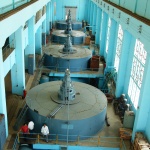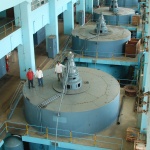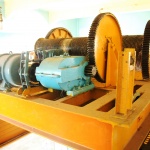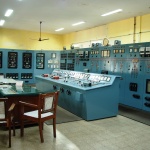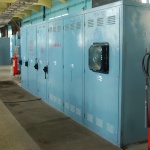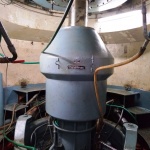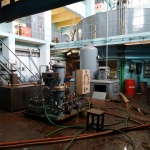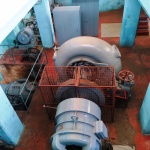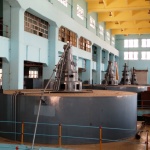
HYDRO-ELECTRIC WING
Although primarily intended as an Irrigation Project, the impounded water in Tungabhadra Reservoir is also utilized to generate power before being let out into the canals for irrigation purpose. The power generated on the left side is entirely used by Karnataka while that generated through two power houses on the right side is shared by states Karnataka and Andhra Pradesh in the ratio of 20:80. One Power House is at the foot of the dam and another at Hampi, 21Km from the dam. The Scheme of generating electricity at these two powerhouses is called “Tungabhadra Hydro Electric Scheme”(TBHES). Work on Dam Power House was taken up in 1951 while that on Hampi power house in 1956. These power houses were commissioned in 1957 and 1958 respectively.
Dam Power House
Dam Power House is located at the foot of the dam. The gross head available at dam powerhouse for generation of power varies from 13m to 26.8m (43ft to 88ft). The four turbines are connected with four steel penstocks, each of 3.3m (11 ft) dia, to the reservoir through butterfly valves. In the first stage, two units each of 9 MW were commissioned on 23rd May 1957 The two units each of 9 MW of second stage were commissioned on 26th February 1964 and 17th June 1964. The total installed capacity of Dam Power House is 36 MW.
The main objective of the project being irrigation, electricity generation is dependent on the water releases made for irrigation requirements in the RBLLC and river assistance to RDS and KC Canal. Water releases vary from time to time as per irrigation demands furnished by the states. During rainy season, especially when the reservoir is nearing 1633ft or isoverflowing, full generation of 36 MW is feasible at the dam power house drawing water at the rate of 5,600 cusecs (153 cumecs) with maximum differential head of 88 ft.(26.8 m).
Hampi Power House
Hampi Power House is fed from the tailrace water from dam powerhouse through the Power Canal. A fore bay is located at the end of this canal which has a storage capacity of 26 Mcft(0.74 Mcum) with normal level of 463.1 m (1,519 ft). The intake structure at forebay has gates, hoists and trash racks. There are two low pressure steel pipe lines (LPPL) each of 5.48m dia (18 ft) and 868.3m in length carrying discharge from forebay to the power house. At the end of each LPPL there is a steel differential surge tank with 18.3m (60 ft) dia and 18.3m (60 ft) in height. There are four penstock pipes each 3.66m (12ft) dia with a maximum discharge capacity of 1,100 cusecs (31.15cumec) two from each of the surge tanks, installed and connected independently to each turbine in the power house.Each penstock is provided with a 3.66 m (12ft) butterfly valve, an air valve at surge tank end and 3.05 m (10 ft) butterfly valve and venturimeter at power house end.
The first unit of 9 MW was commissioned on 10th February 1958 and the second unit of 9MW on 26th March 1958. The remaining two units, each of 9 MW, were commissioned in April and July 1964.
The total installed capacity of Hampi Power House is 36 MW. After generation of power at the Dam Power House water is led into the Power Canal. The discharge carrying capacity of the Power Canal is limited to 2,500 cusecs (70.79 cumec) and hence maximum generation at Hampi Power house is limited to 20 MWs against an installed capacity of 4 x 9 = 36 MW. The generation at Hampi powerhouse is dependent on water discharge through Power Canal. The water discharged from Hampi powerhouse is led into Low Level Canal and is allowed through Gundlakeri escape in case of demand for river assistance.
SHARING OF POWER
The power generated at both the power houses is to be shared in the ratio of 80:20 between Government of Andhra Pradesh and Government of Karnataka

